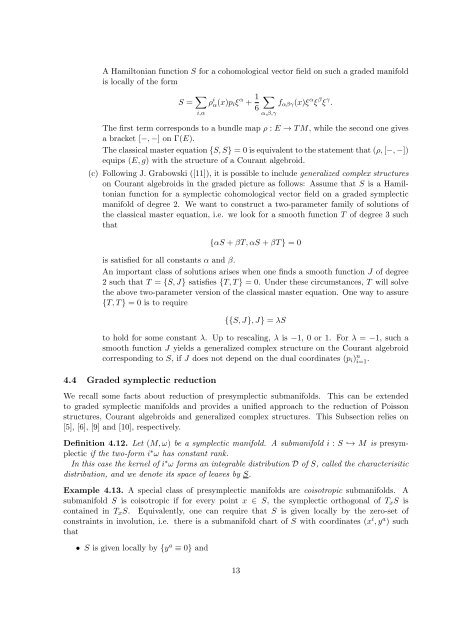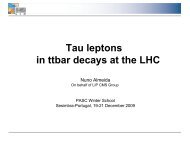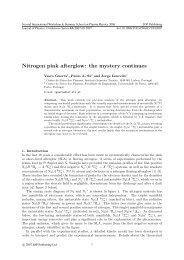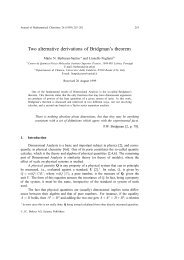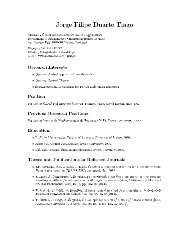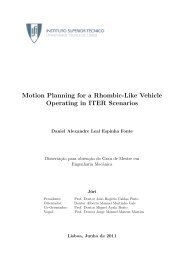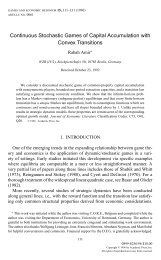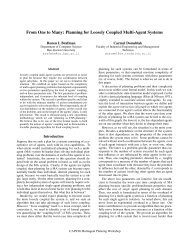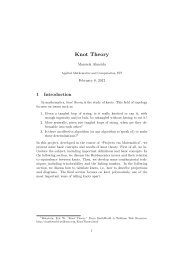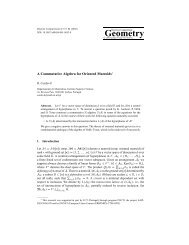Introduction to supergeometry
Introduction to supergeometry
Introduction to supergeometry
Create successful ePaper yourself
Turn your PDF publications into a flip-book with our unique Google optimized e-Paper software.
A Hamil<strong>to</strong>nian function S for a cohomological vec<strong>to</strong>r field on such a graded manifold<br />
is locally of the form<br />
S = ∑ i,α<br />
ρ i α(x)p i ξ α + 1 6<br />
∑<br />
f αβγ (x)ξ α ξ β ξ γ .<br />
The first term corresponds <strong>to</strong> a bundle map ρ : E → T M, while the second one gives<br />
a bracket [−, −] on Γ(E).<br />
The classical master equation {S, S} = 0 is equivalent <strong>to</strong> the statement that (ρ, [−, −])<br />
equips (E, g) with the structure of a Courant algebroid.<br />
(c) Following J. Grabowski ([11]), it is possible <strong>to</strong> include generalized complex structures<br />
on Courant algebroids in the graded picture as follows: Assume that S is a Hamil<strong>to</strong>nian<br />
function for a symplectic cohomological vec<strong>to</strong>r field on a graded symplectic<br />
manifold of degree 2. We want <strong>to</strong> construct a two-parameter family of solutions of<br />
the classical master equation, i.e. we look for a smooth function T of degree 3 such<br />
that<br />
α,β,γ<br />
{αS + βT, αS + βT } = 0<br />
is satisfied for all constants α and β.<br />
An important class of solutions arises when one finds a smooth function J of degree<br />
2 such that T = {S, J} satisfies {T, T } = 0. Under these circumstances, T will solve<br />
the above two-parameter version of the classical master equation. One way <strong>to</strong> assure<br />
{T, T } = 0 is <strong>to</strong> require<br />
{{S, J}, J} = λS<br />
<strong>to</strong> hold for some constant λ. Up <strong>to</strong> rescaling, λ is −1, 0 or 1. For λ = −1, such a<br />
smooth function J yields a generalized complex structure on the Courant algebroid<br />
corresponding <strong>to</strong> S, if J does not depend on the dual coordinates (p i ) n i=1 .<br />
4.4 Graded symplectic reduction<br />
We recall some facts about reduction of presymplectic submanifolds. This can be extended<br />
<strong>to</strong> graded symplectic manifolds and provides a unified approach <strong>to</strong> the reduction of Poisson<br />
structures, Courant algebroids and generalized complex structures. This Subsection relies on<br />
[5], [6], [9] and [10], respectively.<br />
Definition 4.12. Let (M, ω) be a symplectic manifold. A submanifold i : S ↩→ M is presymplectic<br />
if the two-form i ∗ ω has constant rank.<br />
In this case the kernel of i ∗ ω forms an integrable distribution D of S, called the characterisitic<br />
distribution, and we denote its space of leaves by S.<br />
Example 4.13. A special class of presymplectic manifolds are coisotropic submanifolds. A<br />
submanifold S is coisotropic if for every point x ∈ S, the symplectic orthogonal of T x S is<br />
contained in T x S. Equivalently, one can require that S is given locally by the zero-set of<br />
constraints in involution, i.e. there is a submanifold chart of S with coordinates (x i , y a ) such<br />
that<br />
• S is given locally by {y a ≡ 0} and<br />
13


